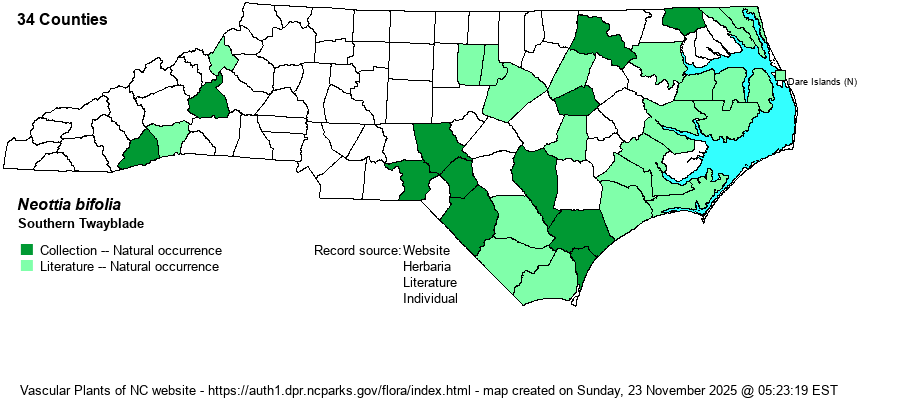| Author | (Rafinesque) Baumbach | |
| Distribution | Present over nearly all of the Coastal Plain, and sparingly into the northeastern Piedmont, west to Orange, Moore, and Richmond counties. Disjunct to the Mountains, where found in only a few counties. Clearly absent over nearly all of the Piedmont and most of the Mountains. Note that there are relatively few county collection records in the SERNEC database. This may be due to the fact that biologists are often reluctant to pick this and other orchid species, especially small ones, as that may require complete removal of a plant (roots and all) and leave very few individuals remaining in the population.
This species has a somewhat odd global range, being present as far north as southeastern Canada and NY, but southward mainly in a narrow band on the Coastal Plain to central FL and eastern TX. There are widely scattered records from western NC to southeastern MO. It is absent in the Great Lakes states and in WV.
| |
| Abundance | Rare to uncommon, and very easily overlooked, over most of the Coastal Plain, less frequent in the inner half of the province toward the Fall Line. Very rare in the northeastern Piedmont. Very rare and local in the Mountains. It is given a Watch List status by the NC NHP, though perhaps this designation is not necessary, especially with records from a minimum of 33 counties, many of recent occurrence. | |
| Habitat | This is a wetland species found in NC mostly in drier portions of swamps, or wetter bottomlands, often on "floodplain islands" within a swamp. In the Sandhills it occurs in wet sphagnum moss of streamhead pocosins, as well as in maple-gum swamps. In the Mountains it is found mostly in wet forested areas under Rosebay Rhododendron (Rhododendron maximum). | |
| Phenology | This is spring-blooming species, typically mid March to early May, rarely to July. It fruits shortly after flowering and seemingly goes underground by early summer. | |
| Identification | This is a tiny and very easily overlooked orchid, and the closer you are to the ground the better for spotting it. Its overall color is a brownish-purple, both the stem and flowers. It grows only to about 6-7 inches tall, with small paired green leaves midway up the stem; they are somewhat ovate and clasping, about 1 inch long at best. The top 40-50% of the stem consists of the raceme of flowers, each with a strongly forked lip about 1/2-inch long, hanging downward. These purplish-brown flowers can look a bit spider-like, but the overall aspect of 10 or more flowers with down-hanging, forked lips gives an oddly pleasing look to a plant when in bloom. The species can occur in modest colonies, up to a few dozen plants. So, when walking in spring in a Coastal Plain bottomland or the drier portion of a swamp, be on the lookout for these tiny brownish-purple plants. | |
| Taxonomic Comments | A synonym found in most older references is Listera australis.
| |
| Other Common Name(s) | Apparently none | |
| State Rank | S3 | |
| Global Rank | G5 | |
| State Status | W1 | |
| US Status | | |
| USACE-agcp | FACW link |
| USACE-emp | FACW link |

